
|
| Trinity, c. 1426-27, commissioned by a member of the Lenzi family from Masaccio for the Lenzi Chapel, Santa Maria Novella, Florence. |

|
| San Lorenzo, c. 1418-1466, original project commissioned by Giovanni di Bicci de Medici from Filippo Brunelleschi; nave built by Cosimo de Medici after 1442 |

|
| Giotto, Approval of the Rule, c. 1300, Assisi, Church of San Francesco |
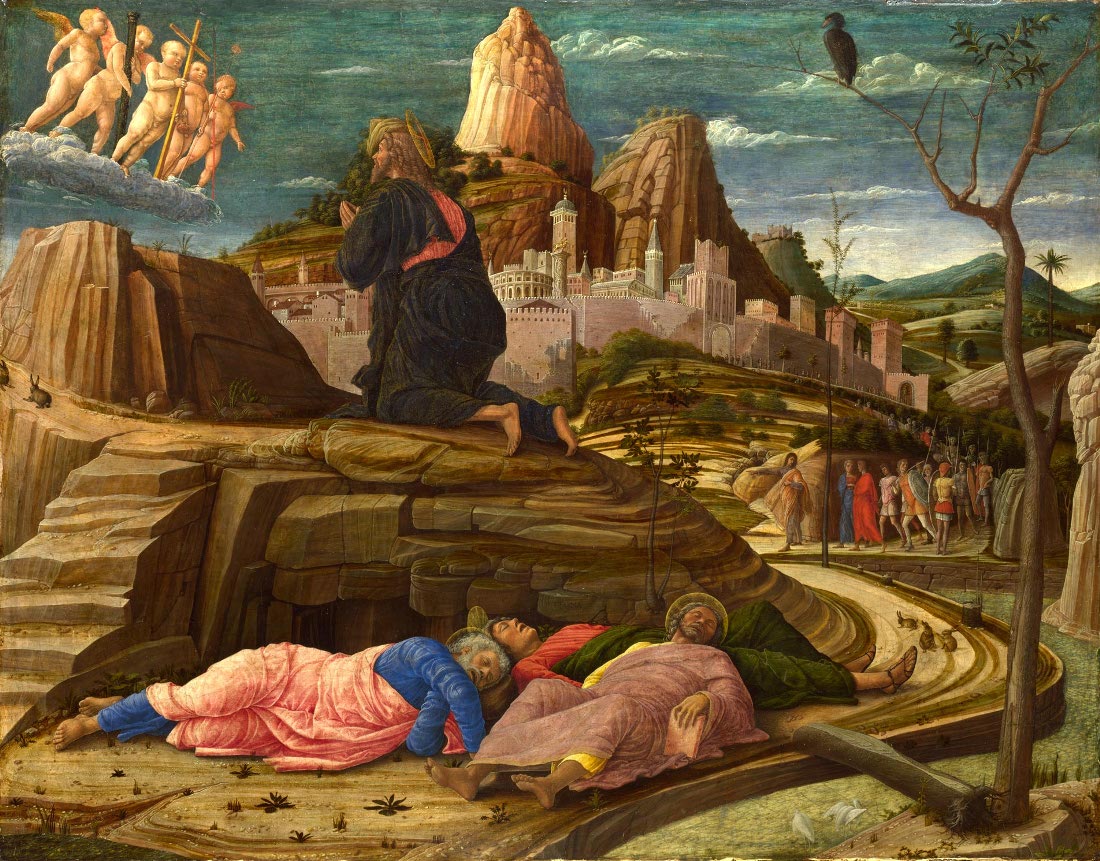
|
|
Andrea Mantegna, The Agony in the Garden, c. 1460, Right panel of the San Zeno Altarpiece,commissioned by the Abbot Gregorio Correr |

|
|
Masolino, Raising of Tabitha and Healing of the Cripple, Brancacci Chapel, S. Maria del Carmine, Florence, c. 1425 |

|
|
Masaccio, Tribute Money, Brancacci Chapel, S. Maria del Carmine, Florence, c. 1425 |

|
|
San Damiano Crucifx, 12th century, unknown Umbrian artist for San Damiano, Assisi. Crucifix where Francis has his vision. Reminder of the divine Christ, not human. Byzantine style. |

|
|
Crucifix, 1270s, commissiond by the Dominicans from Cimabue for San Domenico, Arezzo. More emotional and dramatic. Influenced by Byzantine art. Encouraged worshippers to identify with Christ. |
 
|
|
Altarpiece of St. Francis, 1235, commissioned from Bonaventura Berlinghieri for San Francesco, Pescia. Highly stylized, like an icon. Highly formal figure. Byzantine model. |

|
|
Sancta Sanctorum, 1278, commissioned by Nicholas III from Master Cosmatus for the Lateran Palace, Rome. Pope's private chapel. Decorations link Nicholas to predecessors. Porphyry columns. |

|
| Coronation of the Virgin, c. 1294, commissioned by Nicholas IV from Jacopo Torriti for the apse of Santa Maria Maggiore, Rome. Image of the Church controlling Christian destiny and the popes. |
-large.jpg)
|
| Last Judgment, c. 1290, commissioned by Jean Cholet from Pietro Cavallini for Santa Cecilia in Trastevere, Rome. |

|
| Scrovegni Chapel, Padua, c. 1303-05, frescos commissioned by Enrico Scrovegni from Giotto. Scenes convey Scrovegni's repentance. Uses two point perspective. Using moving narrative rather than iconic style. |

|
| Palazzo della Signoria, Florence, 1299-1310, commissioned by the Florentine government from Arnolfo di Cambio. Express need to defend civic liberty and fight enemies. No classical form. |

|
|
Baptistry, Florence, c. 1059-1150, built by the Opera di San Giovanni. Primary site of civic and religious self-identification. Classicizing style. Represented Florentine pride in Roman past. |

|
|
Baptistry, Florence, mosaics by Coppo di Marcovaldo, late 13th to early 14th centuries. Steeped in the Byzantine tradition. More welcoming image than Cavallini's Last Judgment. |

|
| Santa Croce, Florence, begun 1294, commissioned by the Franciscans w/ support of Florentine government and citizens, probably from Arnolfo di Cambio |
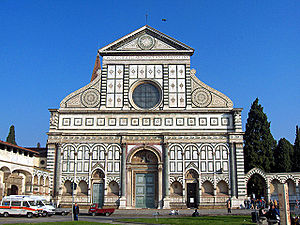
|
| Santa Maria Novella, Florence, founded before 1246, nave begun by 1279, commissioned by the Dominicans with support of the Florentine government and citizens |

|
| Enthroned Madonna and Child (Maesta), 1280s, commissioned from Cimabue for Santa Trinita Altarpiece, Florence. |
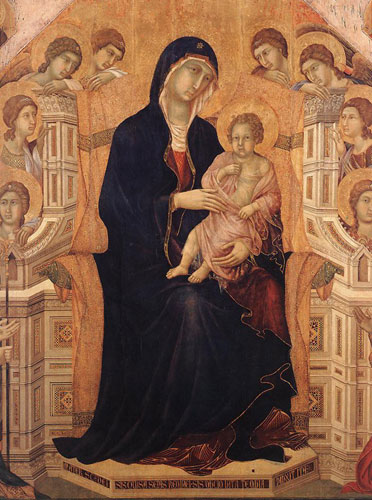
|
|
Enthroned Madonna dn Child (Maesta), 1285, commissioned by the Confraternity of the Laudesi from Duccio for their chapel in Santa Maria Novella, Florence. Altarpiece for the Siena Cathedral's main altar. Expresses dedication of the city to the Virgin. Balance narrative subject w/ iconic style. |

|
| Ognissanti Madonna and Child (Maesta), c. 1310-15, painted by Giotto for the high altar of the Ognissanti Church in Florence. |
.jpg)
|
| South doors, 1330-36, commissioned by the Arte del Calimala from Andrea Pisano for the Baptistry, Florence. |

|
| Pulpit, 1265, commissioned by the Opera of Siena Cathedral from Nicola Pisano for Siena Cathedral |

|
| Siena Cathedral, complete by the 1260s, vaults raised and aspe expanded c. 1355-86, commissioned by the Opera of Siena Cathedral |

|
|
Simone Martini, Maestà, Palazzo Pubblico, Siena c. 1315, commissioned by the governing body of the Nine for the Sala del Consiglio. Integrated some spatial realism and corporeality. Heavily influenced by Duccio's Maesta. Used to depict and admire the city's protectress.
|

|
|
Palazzo Pubblico, Siena, begun 1298, commissioned by the Sienese government. Built so as to rival Florence's Palazzo della Signoria. Campo expands out to symbolize rule expanding out to the population. Gothic arches in window. |

|
|
Allegory of Good Government, 1338-40, commissioned by the Nine from Ambrogio Lorenzetti for the Salla della Pac, Palazzo Pubblico, Siena. Remind council how to properly run Siena. Reminiscent of Last Judgment. She-wolf=Siena's Roman history. |

|
|
Effects of Good Government in the CIty and in the Country, Ambrogio Lorenzzetti, commissioned by the Nine, Sala della Pace, Palazzo Pubblico, Siena. Naturally rendered figures. Barely shows Siena cathedral; demonstrates civil power. As a whole, non-narrative. |

|
| Bad Government and the Effects of Bad Government in the City, Ambriogo Lorenzetti, Sala della Pace, Palazzo Pubblico, 1338-40. |

|
|
Strozzi Chapel, Andrea di Cione (Orcagna), Nardo di Cione, 1354-1357. Change to Gothic style to atone for sins. New pluralism of iconic, Gothic, and Byzantine. Non action, non movement, outside of our time. |

|
|
Strozzi altarpiece, 1354-57, commissioned by a member of the Strozzi family from Andrea di Cione, Strozzi Chapel, Santa Maria Novella, Florence. Incorporates iconography relating to Dominican order. Opulance indicates its importance. Suggest the special relationship between the Dominican order and the papacy. |

|
|
Andrea Bonaiuti, Guidalotti Chapel, Santa Maria Novella, 1365-‐‑1367. Used as a burial chapel for the Guidalotti family. Buonamico Guidalotti's tomb shows he was buried in Dominican habit. Frescos contain natrualism and dramatic intensity. |

|
|
Palazzo Ducale, 1340-1438 (extension towards St. Mark's begun 1242), commissioned by the Venetian government, Venice. Venetian "Gothic" building. Celebrates the conifednce of the Venetian state. Integration of Gothic and Eastern styles shows their dominance of trade. |

|
|
Andrea Bonaiuti, Guidalotti Chapel, Santa Maria Novella, 1365-‐‑1367. Used as a burial chapel for the Guidalotti family. Buonamico Guidalotti's tomb shows he was buried in Dominican habit. Frescos contain natrualism and dramatic intensity. |

|
|
San Marco, Venice, mostly 1063-‐‑1094, with Gothic additions 1384-‐‑1420’s. |

|
| Procession of St. Mark's Square, part of the cycle Miracoli della Croce, 1496, commissioning by the Scuola di San Giovanni Evangelista, Venice, from Gentile Bellini. |
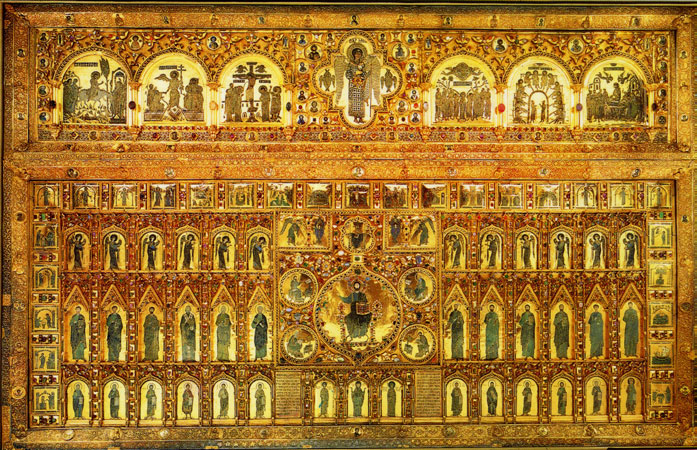
|
|
Pala d'Oro, 976, restored and embellished in 1345 by Andrea Dandolo for St. Mark's, Venice. Golden altarpiece of high altar in St. Mark's Basilica. Pays homage to Byzantine style.
|

|
| Choir screen, 1394, commissioned by Antonio Veier with Pietro Cornaro and Michele Steno, Procurators of St. Mark's, from Pierpaolo and Jacobello dalle Masegne for St. Mark's, Venice. |
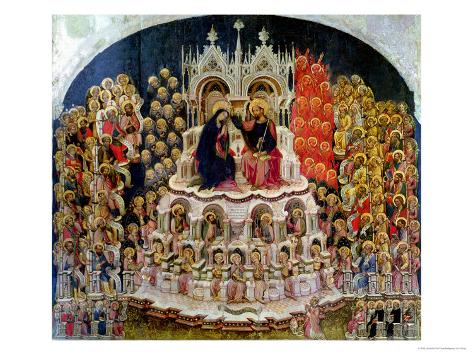
|
| Coronation of the Virgin, early 15th c., commissioned by Bishop Antonio Correr from Jacobello del Fiore for Ceneda Cathedral, Panel. |

|
|
Saint Jerome in his study, Antonollo da Messina, 1460-75. Fundamentally changed Venetian paintings. Heavily incorporated light and geometric depth. Symbolic painting without being narrative or iconographic. Possibly influenced by Flemish, very naturalistic painting. |

|
|
Andrea Mantegna, Dead Christ/Lamentation, c.1480 |

|
|
Giovanni Bellini (Jacopo’s Son), “Francis in Ecstasy”, c.1480 |
|
|
|
Florence Cathedral, Porta della Mandorla, c. 1391-‐‑1397. Highly classical decorative sculpture decorating portal. Overal decoration of the Porta includes Gothic elements. From this, the cohesion of different stylist forms continue in Florentine tradition. |

|
| Sacrifice of Isaac, 1401-03, Lorenzo Ghiberti, doors of the Baptistry, Florence. |

|
| Sacrifice of Isaac, 1401-03, Filippo Brunelleschi, doors of Baptistry, Florence. |

|
|
Isaiah, 1408, Nanni di Bano, north buttress of Florence Cathedral. More classical than Donatello. Unusually youthful. |
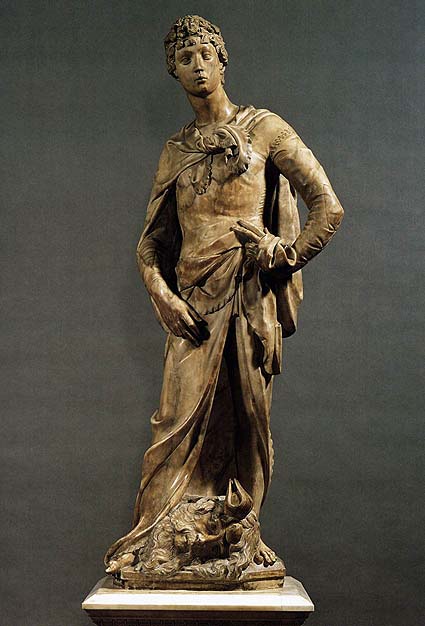
|
| David, Donatello, 1408-09, Palazzo della Signoria, Florence. |

|
| St. Luke, 1408-15, Nanni di Banco, facade of Florence Cathedral. |

|
|
St. Mark, 1408-15, Niccolo Lamberti, facade of Florence Cathedral. International Gothic style. |

|
| St. John, 1408-15, Donatello, facade of Florence Cathedral. |
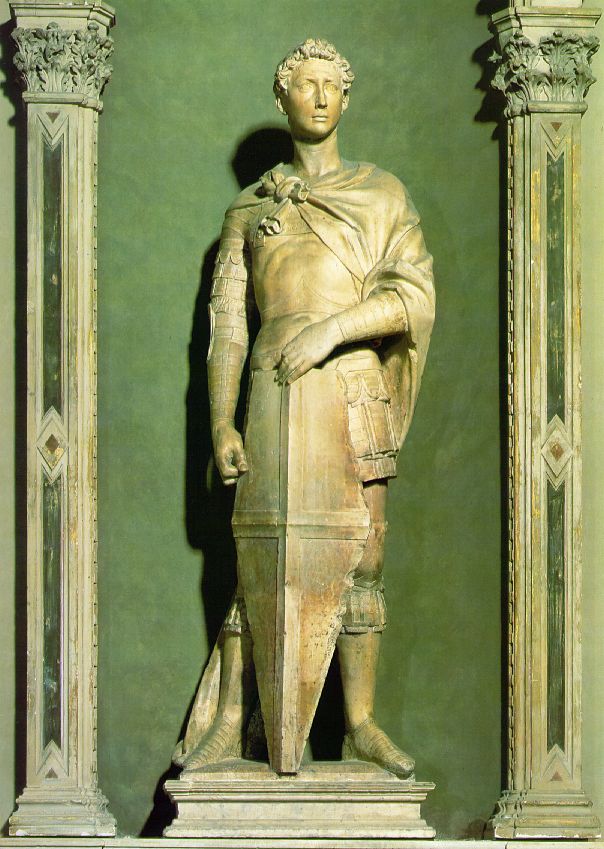
|
|
St. George, 1410-15, Conatello, north side of Or San Michele, Florence. Late Gothic realism in emotion. New empahsis on classicism, but not a copy. |

|
|
St. George and the Dragon, c. 1417, Donatello, Or San Michele, Florence. Schiacciato style, low relief but suggestion of depth. Creates atmospheric base. |

|
|
St. Mark, 1411-13, Donatello, south side of the Or San Michele, Florence. Classical contrapposto figure. Blends classical style with Donatello's own. Realism of expression and skin conveys naturalism. |

|
|
Four Crowned Saints, 1414-1416, Nanni di Banco, north side of the Or San Michele, Florence. Highly classical style appropriate for subject. Placed in highly Gothic niche. Stoic faces=metaphor of Roman morality and personal virtue. Metaphor for responsible citizenship. |

|
|
St. John the Baptist, 1412-17, Lorenzo Ghiberti, east side of Or San Michele, Florence. More contemporary blend of naturalism and stylized International Gothicism. Style contrasts the artists of other guilds. More angular and gaunt face (appropriate for John). |

|
|
St. Louis of Toulose, 1423, Donatello, east side of Or San Michele, Florence. Designed in classical niche. Provides visual analogue of power of Guelf Party, the commissioners. Bronze put him in competition with Ghiberti. |

|
|
Foundling Hospital, begun 1421, Filippo Brunelleschi, Florence. Architecture much more of a copy of Roman columns and style. Very clean, classic style. Where church and corporate foundation work to define the Character of Florence. |
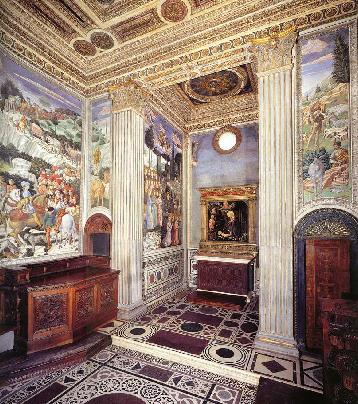
|
| Medici Chapel, Medici Palace, c1459, Florence, Benozzo Gozzoli |

|
|
San Lorenzo, 1418-66, Filippo Brunelleschi. Represented the Christian history of Florence. Demonstrated the importance of Medici heritage |

|
| Old Sacristy, San Lorenzo, 1418-28, Filippo Brunelleschi. |

|
| Gentile da Fabriano, Adoration of the Magi, 1423, Cappella Chapel for Santa Trinita, Florence. |

|
|
Paolo Uccello, Battle of San Romano, c. 1430’s |

|
|
Masacco and Masolino, Brancacci Chapel, S. Maria del Carmine, Florence, 1424-‐‑1427 |
,_1376-78,_battistero_di_Padova.jpg/250px-Giusto_de'_menabuoi,_paradiso_(detail),_1376-78,_battistero_di_Padova.jpg)
|
|
Padua Baptistery, 13th ct. Frescoes 1370’s by Giusto de Menabuoi. Influences design for Old Sacristy.
|

|
|
Donatello, Door of the Apostles, Old Sacristy, Florence, c. 1434 |

|
|
San Marco, Florence Rebuilt by Michelozzo, c. 1436. Under Dominican order. Cosimo di'Medici commissioned it. |
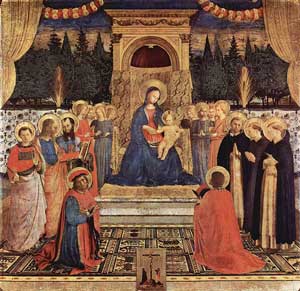
|
|
San Marco altarpiece, 1440, Fra Angelico, high altar of San Marco, Florence.
|

|
|
Tabernacle, San Miniato al Monte, Florence Michelozzo, 1447-‐‑1449
|
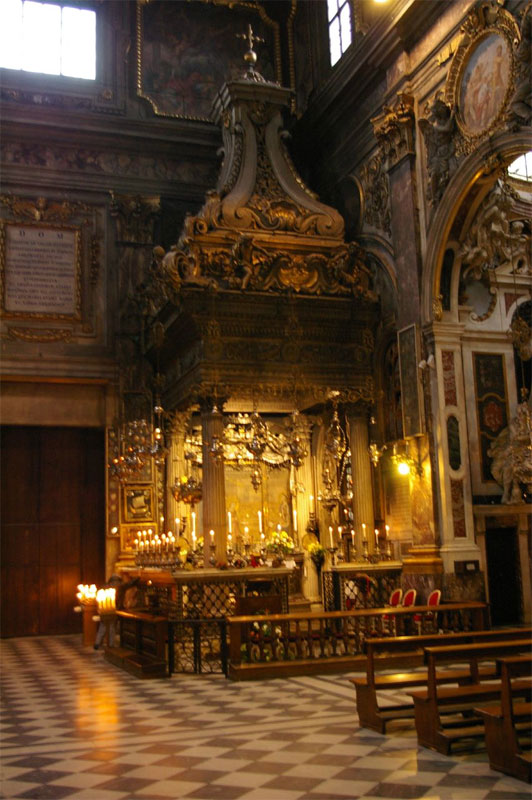
|
|
Santissima Annunziata, Florence, tabernacle of 1448, Michelozzo |

|
|
Private Chapel, Medici Palace, painted by Benozzo Gozzoli, c. 1459 |

|
|
Journey of the Magi, 1459, Benozzo Gozzoli, Private chapel, Medici Palace. Heavy amount of power iconography balanced with meditational iconography. Gave royal cast to the family. Celebrated their civic generocity and religious devotion. |
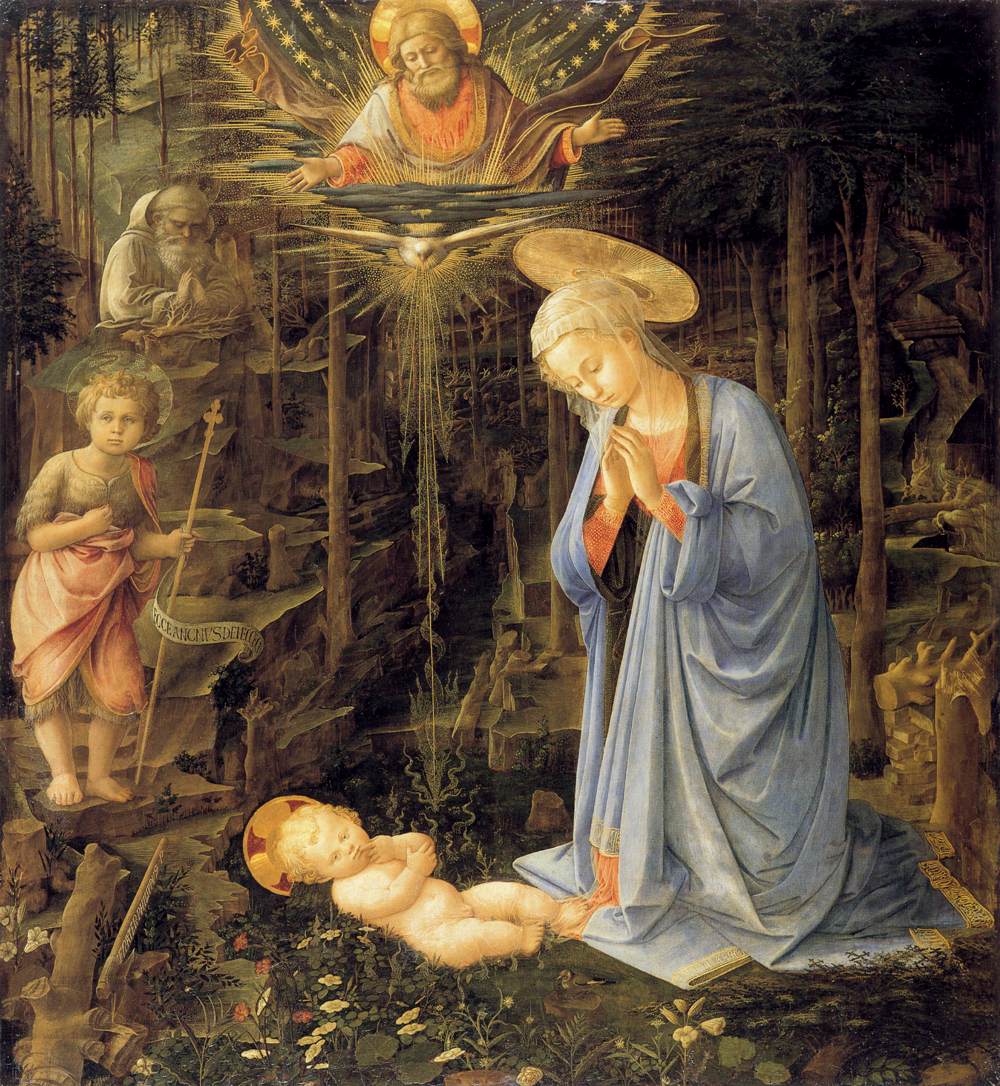
|
|
Fra Filippo Lippi Adoration of the Christ Child Late 1450’s, Medici Palace. Complex amalgam of civic and devotional imagery. Warning against immortality. Deeply meditative befitting its patrons. |

|
|
David, 1460s, Donatello, Medici Palace. Civic medium of bronze. Oddly sensual depiction of David. Evokes Mercury imagery. Triumph over civil tyranny. |

|
|
Judith and Holofernes, late 1450s, Donatello, Garden of Medici Palace. Represents the Medici triumph over civic tyranny. Also represents civic propriety, virtue, and political control. |
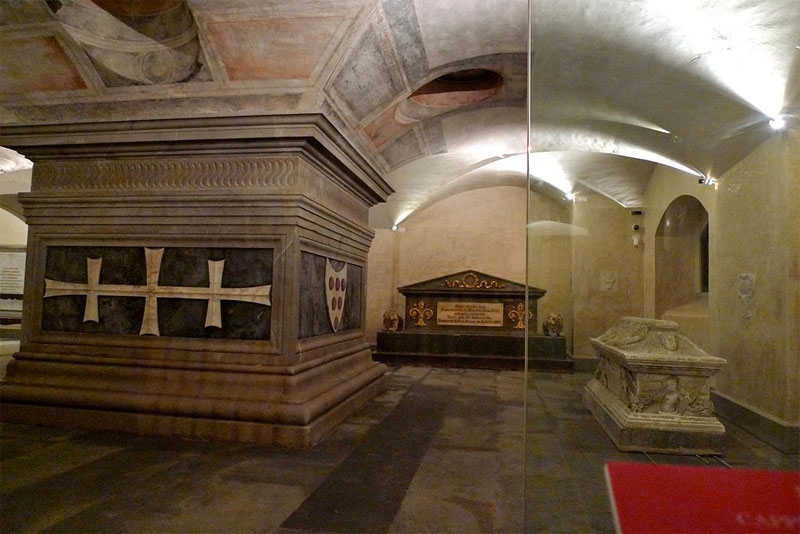
|
|
Verrochio, Tomb of Cosimo de’ Medici San Lorenzo, 1465-‐‑67 |

|
|
Incredulity of St. Thomas, 1465-83, Andrea del Verrocchio, Or San Michele, Florence. Frequently a symbol of justice. |

|
|
Botticelli, Primavera c. 1482. Generated a new courtly art. Diverte from conventions of naturalism and narrative focus. Venus exemplifies fertility of Mary |

|
| The Birth of Venus, 1480s, Botticelli. |

|
|
Santa Maria Maggiore altarpiece, Masolino, high altar of Santa Maria Maggiore, Rome, 1423-27. Use style and iconography (uses early stories to assert papal power). Pyramid in backround from ancient Rome. |

|
|
Doors of Old St. Peter's, 1445, Filarete, commissioned by Eugenius IV from Filarete, main entrance of Old St. Peter, Rome. One of the first Humanist artists |

|
|
Fra Angelico, Chapel of Nicholas V, Vatican Palace, 1448-‐‑1455. Iconography of St. Steven and St. Lawrence: scenes depicting papal power. Papal power spread through spreading word of God. In private chapel, it was to remind Pople of his abilities.
|

|
| Palazzo Venezia, begun 1455 for Pietro Barbo, later Paul III, Rome |

|
|
Palazzo della Cancelleria, Rome, after 1483. Great size, regular composition, clasicizing decoration. Domination over the urban landscape. Became for a model for later Roman places.
|

|
|
Christ Giving the Keys to Peter, Pietro Perugino, 1481-82, Sistine Chapel. Background shows Constantine's Triumph to represent Christianity's success and continutiy. Florentine architecture used in vocab. Reminds conclave of papal legacy. |
|
|
|
Hospital of Santo Spirito, 1473, commissioned by Sixtus IV. Papacy becoming new imperial force, shown through classicizing element. French Gothic window tracing. Medieval classicizing vocabulary. |

|
|
Santa Maria del Popolo, Rome, Baccio Pontelli, 1472-1480.
|

|
|
Melozzo da Forli, Sixtus IV Confirming, Platina as Papal Librarian, Rome, Vatican, c. 1477 or 1480. Fusion of comtemporary w/ classicizing elements. Oak leaves w/ acorn, symbol of Sixtus IV's family. |